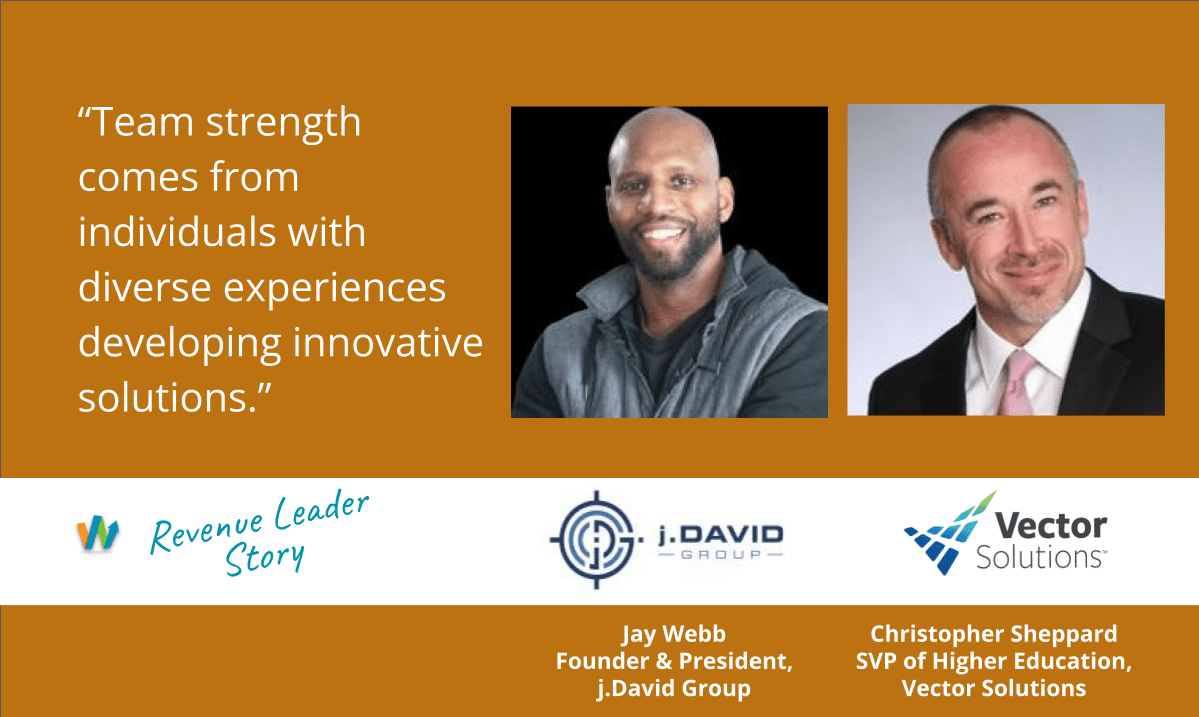
How well do you leverage a diversity of backgrounds to build a high-performing sales team?
“Building a diverse team is one of the keys I have found to consistent high-performance in sales,” says Christopher Sheppard, SVP of Higher Education at Vector Solutions. “Individuals with different experiences see problems differently and come up with different solutions. That diversity of solutions is critical in a demanding buyer environment.”
Nearly 80% of sellers are white and 60% are men. Christopher’s current team at Vector, by contrast, is 60% women, 40% people of color and 20% from the LGBT community. His previous teams at DecisionDesk and EverFi had a similarly diverse composition. Christopher credits diversity as a key ingredient in his track record of consistently getting 80% of his teams to quota achievement, well above the industry average of 60%.
Jay Webb, a sales recruiter with a specialty in diversity hires, echoes Christopher’s comments. “Building a diverse sales team requires new ways of thinking and new processes, but it is worth the investment.” Jay cites research from Scott E. Page, a University of Michigan professor, who has documented with empirical rigor the “diversity bonus” that creates high-performing teams.
I recently spoke to Christopher and Jay about building diverse teams. Here are their key practices:
Practice 1: Make Diversity a Priority
“It starts with what you value and measure,” Christopher says. “I have worked for companies where recruiting for a diverse team was a measurable goal for leadership. The informal commitment from leadership, seeing diversity as a core value, is just as important.”
Christopher notes that his team sells a safety and wellness application into higher education, a mission-driven, diverse market. “It’s important your sales team represents your customers,” he says.
Jay, who specializes in SaaS recruiting but works across a range of industries, adds “the reality today is that even outside of higher education most markets have a diverse set of buyers.”
Practice 2: Focus on the Right Skills
“Diversity becomes a strength when it is anchored to a set of shared commitments,” Christopher explains. “Everyone on our team has been recruited because they have deep passion for the mission of higher education. They also see themselves foremost as ‘buyer problem solvers’ and are open to ‘constructive tension’ that contributes to improvement.”
His team’s shared commitments make it possible to have passionate debate and even open conflict, but when the debate is over they can walk away and still “share a meal or beer together.”
Jay agrees that “the focus on soft skills like mission alignment, coachability, resiliency, and adaptability is exactly right to build a diverse team.” Sales leaders that start with an exact job spec, like “I need five years of experience in cybersecurity and business development with start-up experience” can often disqualify a diverse hire from the outset. Jay even encourages relaxing a 4-year degree requirement as it structurally disadvantages candidates of color.
Practice 3: Expand Sources of Recruiting
“You also have to be open to widening your search,” Jay says. “You’re going to find more diversity in Chicago, Atlanta, Detroit and other major metro areas. Since many of us are not going into the office, it really does not matter as much where your sales team is located.”
On expanding sources of recruiting, Christopher adds “we all know that your employee network is the best source of talent, but if you are looking to build a diverse team you need to look outside the employee network. Otherwise you will end up with a team that looks a lot your current team.”
Across his roles at Decision Desk, EverFi, and now Vector Solutions, Christopher has found he needs to continually “get out of his comfort zone” and go to places and spaces where he was not previously showing up. To build diverse teams, he expanded geographically per Jay’s suggestion, found new job fairs, and spent more time at historically black colleges and universities (HBCUs) or Hispanic-Serving Institutions (HSIs) vs. the flagship public universities.
Practice 4: Build Pathways to Success
“Once you get to a critical mass of diversity, things get easier as you can rely more on your employee network,” Christopher comments. “Prior to that, it is really important to explicitly create career pathways for diverse candidates and include this discussion in your recruiting process.”
Christopher and Jay reinforce that many diverse candidates will go immediately and look at your leadership page as a proxy for the company’s commitment to diversity. If that leadership team does not yet represent your target level of diversity, then it is really important for diverse candidates to understand your company’s investment in skills development and career pathing.
Jay notes, “being able to speak to strong onboarding and coaching programs can really help with diverse candidates. Many have experienced frontline sales managers who are not fully confident in training and coaching their teams.”
Christopher’s and Jay’s experiences helping one company after another build diverse, high-performing teams is more evidence for the power of the “diversity bonus.” Their experiences are also a good reminder that nothing worthwhile happens overnight. Building a diverse team takes time and a commitment to building new processes and new approaches.
